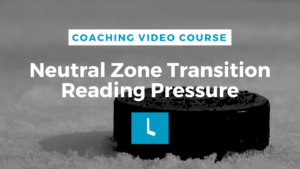(Transcribed from How to Play Hockey: Our Minor Hockey Coaching Course.)
Let’s talk now about ‘controlled breakouts’ in North America. These are most common on the powerplay. So I think for the sake of these videos we will discuss this as a power play . You will notice that in Europe on the big ice surface a controlled breakout is often used against a passive one-to-two forecheck which we will get to in our forechecking section.
It’s a way to slow down the game and buy time and create some space. They generally all start with the defenseman setting up behind the net and using that net as some protection from a forechecker. I’m going to go through a number of controlled breakouts in this video just to give you a different perspective. And all of them will have little tweaks. You can change this or change that but you’ll see some common themes.
Most common theme is that you generally try to create width in your attack and depth in your attack. And that you are also trying to isolate a forechecker to create a two-on-one situation so where one pass is made it beats a forechecker. The goal would be to carry the puck under control all of the way into the offensive zone.
[maxbutton id=”2″ ]
Let’s start with a really easy one that you could execute at whatever level you’re probably playing if you’re watching this video…
Example #1:
- The W’s are stretched on the far blue line which instantly force the opposition’s D to come back. If they don’t come then we can get the puck to a W and your in on a breakaway.
- D1 has started with the puck behind the net. Perhaps the other team’s forecheckers are in some kind of passive formation.
- D2 is often in one of the defensive zone corners for a quick outlet pass from behind the net.
- The C swings low through the middle towards the wall, generally on his/her forehand side to be able to receive a pass well
- Let’s say we pass the puck to our C who was a skilled player, carrying the puck up the wall.
- D1 can continue to come in a staggered formation up the middle of the ice or to be specific towards the inside shoulder of the C carrying the puck as pass back option.
- D2 continues to go up the wall so that if the C makes that back pass we can then go from D1 to
- D2. Now we’ve moved it again from strong side to weak side.
- Generally if this play happens you want the strong side W to get off the wall coming through the middle of the ice staying on side for support with timing. That was as well if the C continues to carry the puck into the zone we don’t have the players being checked by one opponent.
That last part can be tough to manage though and is a skilled play to execute. So again the two W’s go stretch the ice, the C swung to a corner, the D2 swung down low to the other corner while D1 with the puck moves up and these… one, two, three players come up together trying to make passes generally with lots of ice to work with as the W’s are stretched out.
We gave you a nice simple option above but as you can imagine there’s lots of options. Make sure to take a look at the video for a far more detailed description of more options for you and your team!
I think it is a great way in these videos to show you some of those options and you could pick one that is useful if you’re at a higher level say a junior hockey team. One power play line could use one of these breakouts and another power play line could use another one.
Thanks for watching see you the next video!
Looking to download half ice hockey practice plans, goalie drills for teams (not a goalie coach?!) or small area games drills? We’ve got you covered too. Click here. Perfect for recreational level coaches.





